Monday Feb. 13, 2006
Optional Assignment #2 was collected in class. A handout with
answers to the questions was distributed together with the Quiz #1 Study Guide (Quiz #1 is Wednesday,
Feb. 15, and will cover material on both Quiz #1 Study Guide and the Practice Quiz Study Guide).
A survey on student understanding of the greenhouse effect was
conducted in class. The survey will be readministered later in
the semester (after having covered the topic in NATS 101) to determine
whether you understand the concept better or whether the class has
actually decreased your understanding.
The Experiment #1 reports are graded and can be picked up from the
instructor. Revised Expt. 1 reports and the Expt. #2 reports are
due on Monday, Feb. 28.
The
following figure (from p. 41 in the photocopied notes) shows some of
the relationships that exist between surface and upper level weather
map features (this figure was
redrawn after class for improved clarity)
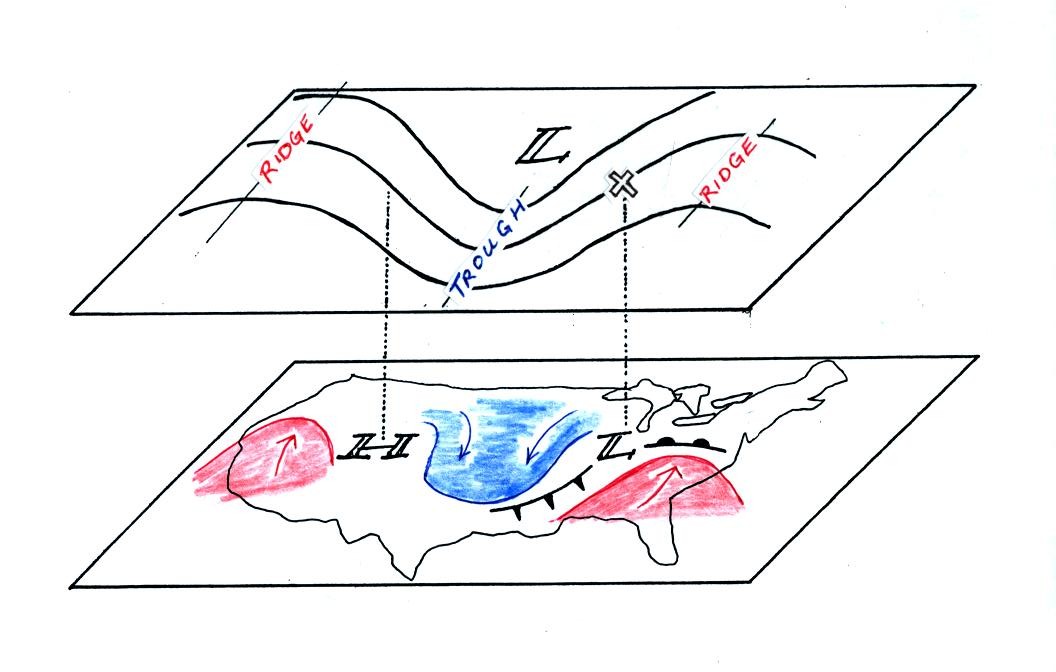
On the surface map you see centers of HIGH and LOW pressure.
The low pressure center, together with the cold and warm fronts, is a
middle latitude storm. A storm of this type is what brought the
stormy weather to the east coast of the US this past weekend.
Note how the counterclockwise winds spinning around the LOW move warm
air northward (behind the warm front on the eastern side of the LOW)
and cold air southward (behind the cold front on the western side of
the LOW). Clockwise winds spinning around the HIGH also move warm
and cold air.
Note the ridge and trough features on the upper level chart. We
learned that warm air is found below an upper level ridge. Now
you can begin to see the source of this warm air. Warm air is
found west of the HIGH and to the east of the LOW. This is
where the two ridges on the upper level chart are also found. You
expect to find cold air below an upper level trough. This cold
air is being moved into the middle of the US by the northerly winds
that are found between the HIGH and the LOW.
Note the X marked on the upper level chart directly above the
surface LOW. This is a good location for a surface LOW to develop
and strengthen. The next figure (from p. 42 in the photocopied
notes) will give you some idea of why
this is true.
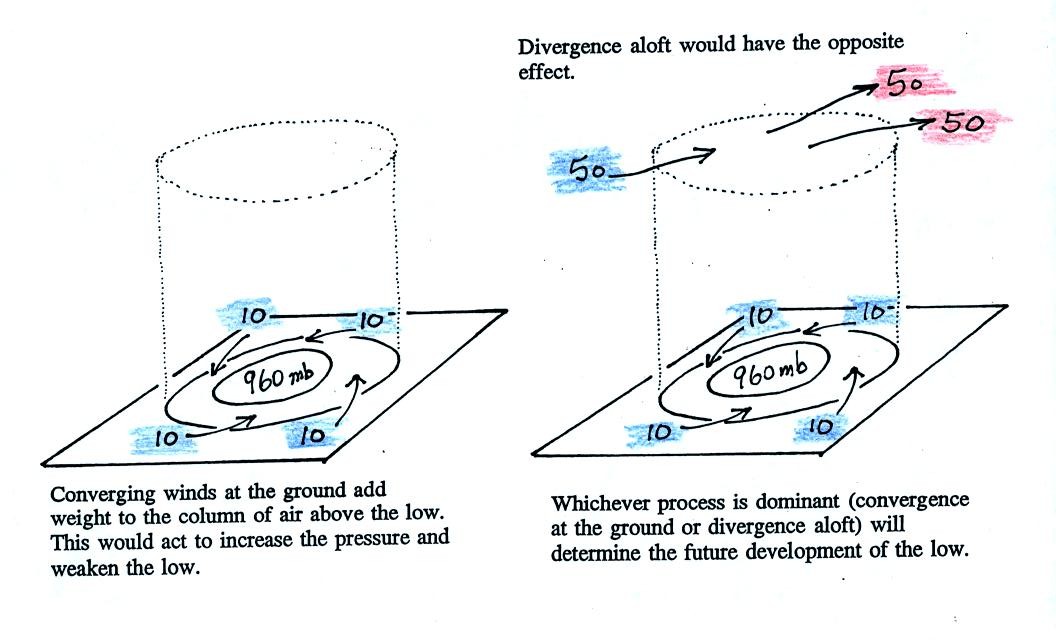
We'll start with the figure at left (modified slightly from the figure
shown in class). We see a surface LOW (with 960 mb
pressure). Winds are spinning counterclockwise and spiraling in
toward (converging) the center of the low. These surface winds
are moving air into the column of air and (as explained on the figure)
should cause the pressure in the center of the LOW to increase.
Imagine that each arrow brings in enough air to increase the pressure
at the center of the LOW by 10 mb. You would expect the pressure
at the center of the LOW to increase from 960 mb to 1000 mb. What
if the central pressure actually decreased? How would you explain
that?
This is just like a bank account. You have $960 in the bank and
make four $10 dollar deposits. You would expect your bank account
balance to increase from $960 to $1000. What if your account
balanced dropped? How would you explain that?
The right hand figure shows what is going on. We haven't included
the effects of addition and removal of air at upper levels.
Imagine that 50 mb worth of air are added to the column and 50+50=100
mb worth of air are removed. That's a net removal (net
divergence) of 50 mb.
So now we have 40 mb worth of air being added at the ground (surface
convergence) and 50 mb worth being removed at upper levels (upper level
divergence). The grand total is 10 mb of removal. The
surface pressure will decrease slightly.
You can apply the numbers in the right hand picture to the bank account
problem. You have $960 in the bank and make 4 $10 deposits.
However you also deposit $50 dollars and make 2 $50 withdrawals (the
top of the picture). That's a total of $90 being deposited and
$100 being withdrawn. Your bank account goes down $10.
In a case like this where upper
level divergence > surface convergence, the surface LOW
pressure will get even lower (the low will "deepen") and the storm will
strengthen. Click here if
you dare and if you would like to see what could happen next.
The other possibility is that the upper level divergence <
surface convergence. In this case the LOW pressure will
increase (the low will "fill") and the storm will weaken.
Click here for some additional
examples. By working through some additional examples you might
increase your understanding of this material and build up your
confidence (of course there's always a chance that more examples will
just make this topic more confusing - the choice is yours)
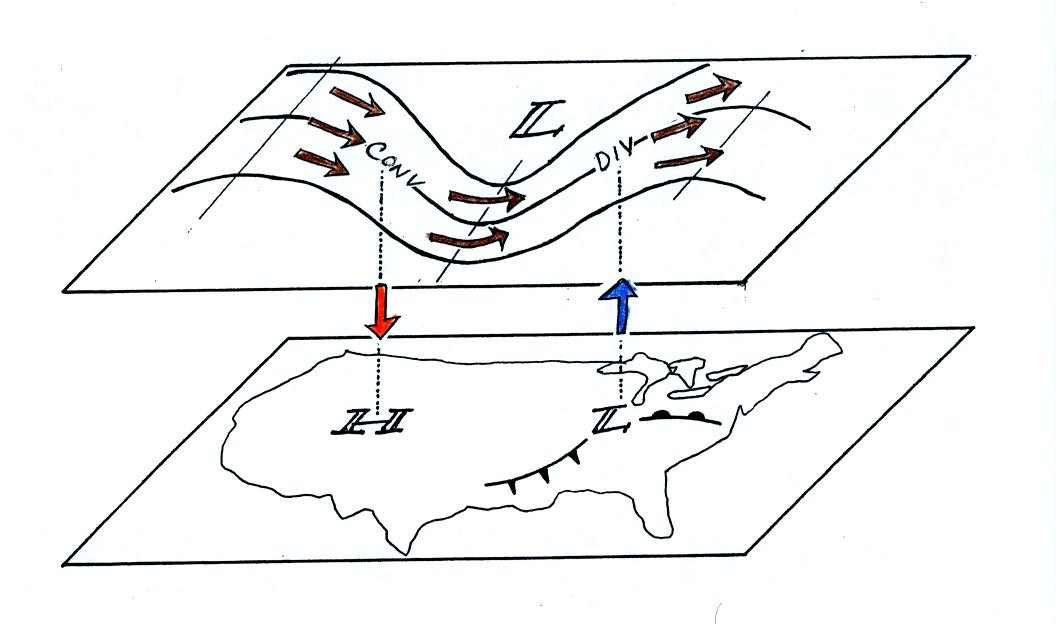
This figure wasn't shown in class.
Now that you have some idea of what upper level divergence looks like
you are in a position to understand another one of the relationships
between the surface and upper level winds.
One of the things we have learned about surface LOW pressure is that
the converging surface winds create rising air motions. The
figure above gives you an idea of what can happen to this rising air
(it has to go somewhere). Note the upper level divergence in the
figure: two arrows of air coming into the point "DIV" and three arrows
of air leaving (more air going out than coming in is what makes this
divergence). The rising air can, in effect, supply the extra
arrow's worth of air.
Three arrows of air come into the point marked "CONV" on the upper
level chart and two leave (more air coming in than going out).
What happens to
the extra arrow? It sinks, it is the source of the sinking air
found above surface high pressure.
Next
despite some resistance from the class we forged ahead into Chapter
2. A short introduction to the material in Chapter 2 was
postponed until Friday's class.
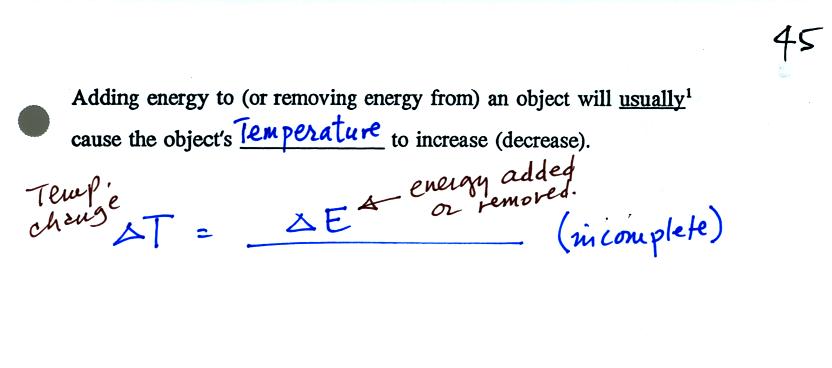
From the top of p. 47 in the photocopied notes: if you add energy to
(or remove energy from) and object the object will usually warm up (or
cool off if you remove energy).
We need to come up with an equation that tells us exactly how much of a
temperature change there will be. The temperature change will
first depend on the amount of energy added (or removed).
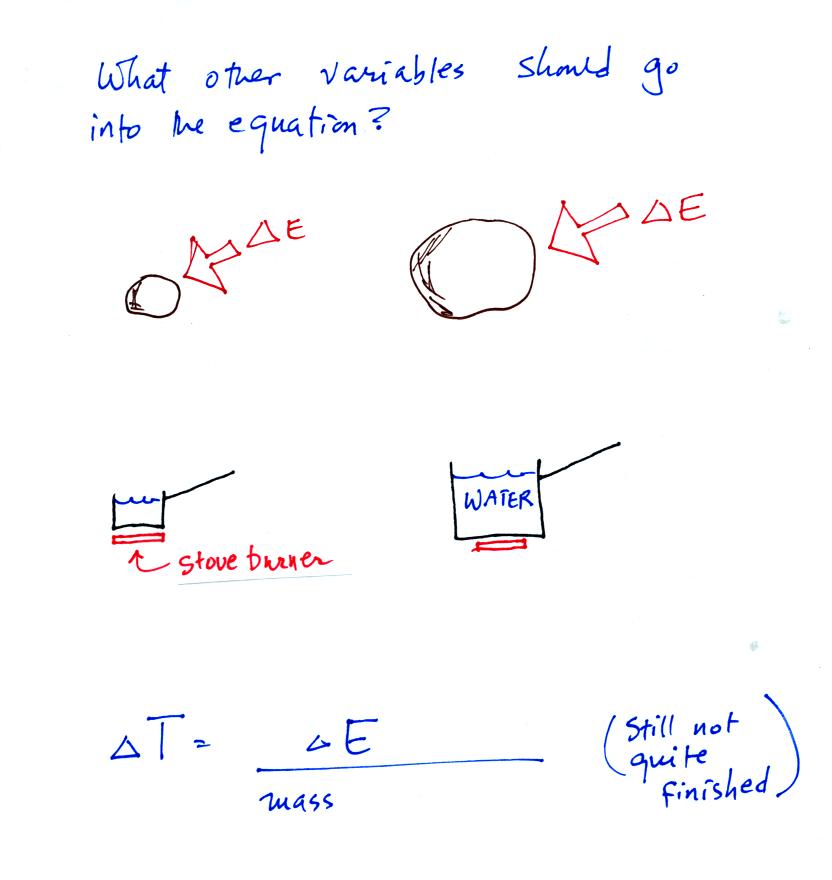
If you add equal amounts of energy to a small rock and a large rock,
the small rock will warm up more than the large rock. If you
place small and large pans of water on equal sized stove burners, the
small pan will heat up more quickly than the large pan of water.
These examples tell us that the temperature change depends on the
amount of material being heated (or cooled). The mass (not the
volume) should appear in the denominator of the equation.
There is one last term, the specific heat. Different
materials warm (or cool) differently even when equal amounts of energy
are added to equal masses of materials. We'll look at an
important example on Friday.
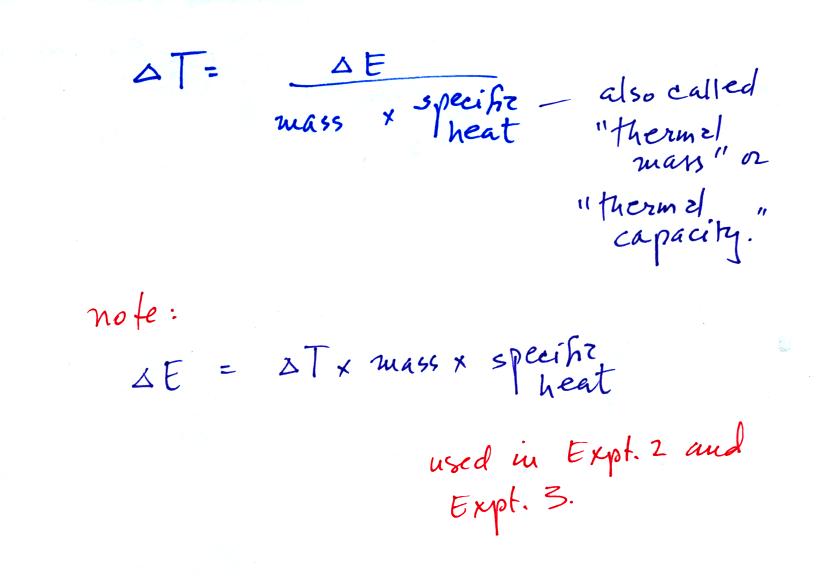
Here's the finished equation. The specific heat is sometimes
called the thermal mass. An material with large specific heat
will warm or cool slowly when energy is added or removed (just as an
object with large mass would warm or cool slowly).
Note the slightly different form of the equation. You can measure
the amount of energy added to or removed from a material of known mass
and specific heat by measuring the change in the object's
temperature. This relationship is used in Experiments 2 and 3.
Adding or removing energy will usually cause a change in
temperature. Not always:
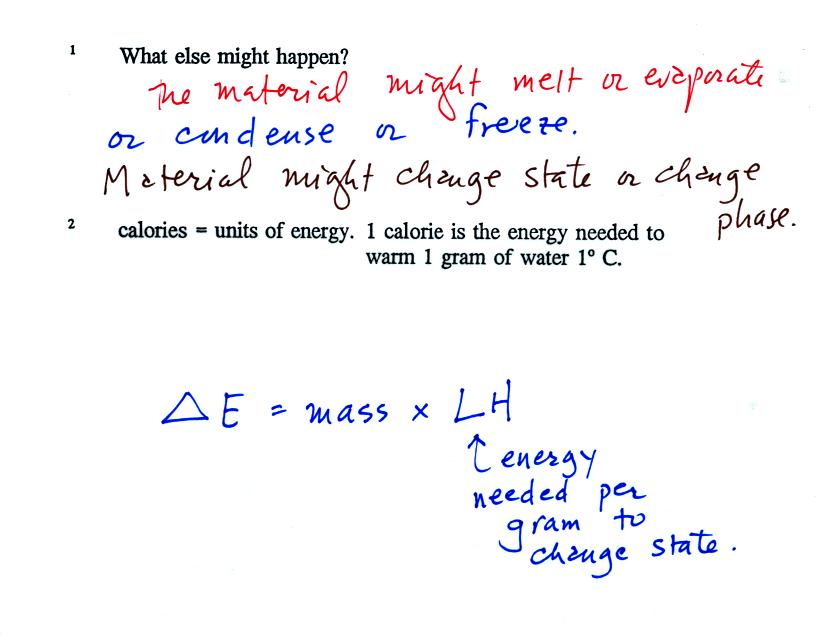
The equation above tells you how much energy must be added to cause a
material to melt or evaporate (or how much energy must be removed to
cause the material to condense or freeze). LH stands for "latent
heat."
A small
experiment was performed at the end of class to make use of these two
equations (the equation relating energy and temperature change and the
latent heat equation just mentioned). The goal of the experiment
was to measure the latent heat of vaporization of liquid nitrogen - the
energy needed, per gram, to evaporate nitrogen.
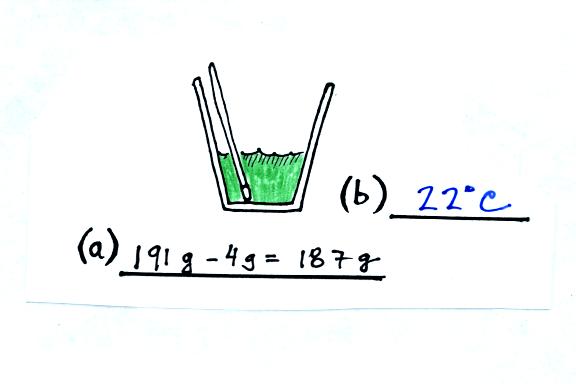
We first measure the mass and temperature of some
water. The water plus the cup weighed 191 g. We subtracted
the 4 gram weight of the cup.
The
water will be the source of the energy needed to evaporate liquid
nitrogen. By measuring the temperature of the water before and
after the liquid nitrogen is evaporated, we will be able to determine
how much energy was used.
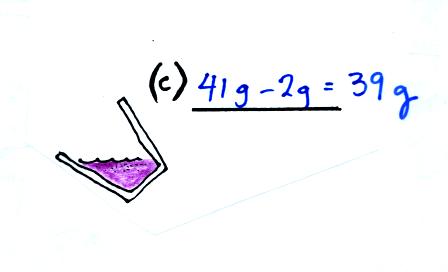
We also need to measure the mass of liquid nitrogen (the cup
weighed 2 g).
We don't
need to worry about the temperature, it's -320 F. The liquid
nitrogen can't get any warmer than that and still remain a liquid.
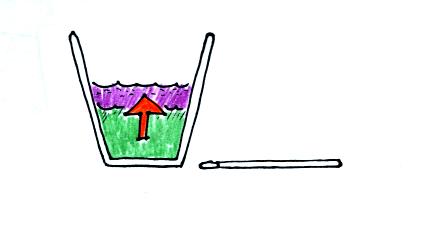
We pour the liquid nitrogen into the cup of water and
wait.
Energy will flow from the warmer water into the very much colder liquid
nitrogen. We perform the experiment in a styrofoam cup and assume
that no energy is flowing into the air in the room (because the water
started out at room temperature there won't be much energy flowing from
the water into the room anyway).
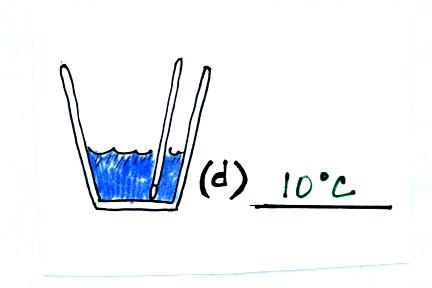
Now we remeasure the temperature of the water. The
water should
be colder because some of its energy was used to evaporate the
nitrogen. We assume that the mass of the water has stayed the
same.
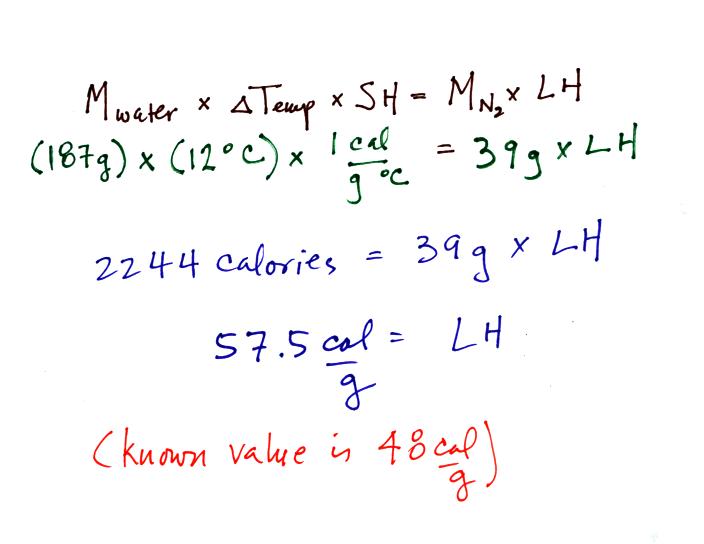
Now we use an energy balance equation. On the left is the energy
taken from the water. Removing this energy cooled the water from
22 C to 10 C, a change of 12 C. The specific heat of water is 1
calorie per gram per degree Celsius. On the right is the energy
needed to evaporate the liquid nitrogen. In our case we
evaporated 39 grams. We plug in all our measurements and solve
for LH.
We obtained 57.5 calories per gram. The known value is 48
cal/g. So our measurment was close (though the experiment went
much better in the Thursday morning class - the measured value was 48.2
cal/g).











